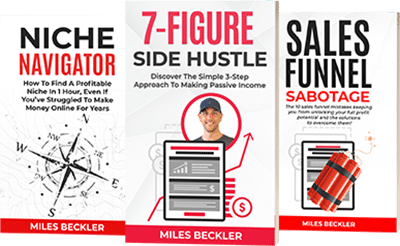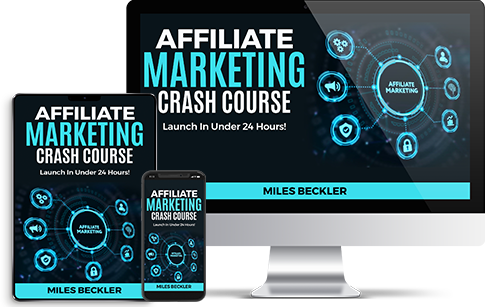Imagine a world where you get income to write about things you like…
Where you are free to set your own schedule and make as much money as you want…
Where you are your own boss, which means no nagging, no overtime, and definitely no restrictions….
Who wouldn't like to travel to that world?
All you need is an awesome blog that offers real value, not boring pieces of content that people hardly read/like.
Wondering how to make money blogging? Well, it’s not a walk in the park.
Like several other ways to make money online (such as affiliate marketing, selling online courses or other digital products, social media marketing etc), it needs A LOT of hard work. This is why not all bloggers are getting a steady income from their blogs.
In fact, I think that for bloggers, generating an income from selling digital products is far more difficult than generating an income selling physical products. Why? Because your buyers can't ‘touch and feel' what they're buying.
This is why it's important to use the right words and content on your blog, especially if you wish to make money blogging. And that's where most bloggers fail.
Want to make money from your blog? Read on…
In this article…
You’ll learn what it takes to make big time money blogging.
Here, you'll learn how to start your own blog and structure it, to how to brainstorm blog post ideas, you are going to learn it all in this simple, step by step guide.
Plus, you’ll discover a secret weapon that you can use to help your visitors find what they’re looking for, driving in a massive amount of traffic and generating multiple income streams.
Want to know how to start? Great, let’s jump in.
What Do You Need To Make Money Blogging?
First things first, if you really want to know how to make money blogging, you need to start a blog.
Starting a blog is simple. Here’s how to do it, in 3 steps.
Choose A Niche

The first step is to choose a niche that stimulates you and overlaps with what you’re already good at.
The more you enjoy writing in your niche, the better your chances of success.
So opt for something you really love writing about, and you'll have income flowing into your bank account every month in no-time!
Not sure how to choose the perfect niche? Learn how for free in this “how to choose a profitable niche” course, here.
Your ultimate aim to make the most money blogging is to grow an authority website.
Get A Domain Or Buy A Niche Website

Once the niche is decided, the next step is to start your website, and that starts by choosing your domain name.
Be careful about the blog name (your domain name) you choose, as it can make or break your dream of making money blogging.
Your domain name should be easy for people to pronounce, and it should be relevant to your niche.
You can either purchase a domain from a web hosting service provider like A2 Hosting and build a website yourself or buy a pre-built site already connected to Google from a service provider HPD.
Set Up Hosting and Google Analytics
When it comes to hosting your blog, I can’t recommend A2 Hosting enough. They are super economical, help you get started with WordPress for free, and their customer service is top-notch.
Just go for their LITE plan, and you can get your blog hosted for around $60 to $80 per year. Cheap!
After you have WordPress live, it’s time to start tracking your traffic using Google Analytics!
Check out my detailed Starting A Blog guide here, and you’ll learn the entire foundation of setting up your hosting, Google search console, Google analytics, and more in super-simple steps.
Engage The Shotgun SEO Approach To Boost Traffic (And Income)
The whole point behind shotgun SEO is to start getting traffic to your blog, fast. You don’t make a great deal of money with this approach, but you do build some crazy traffic, which by the way is the first step toward making money blogging.
As a by-product, you can start gathering email addresses from visitors. Gaining email subscribers and learning how to market to your email list is a huge step on the path to leveling up your blog income.
Step 1: Research Keywords Or Buy A KGR Keyword Package

Keyword research is a necessity if you wish to start a high-performing blog that readers and search engines will like. It helps you find out the hot topics/queries relevant to your niche and helps you to find out what your audience is searching for so that you can answer those queries in your posts.
But if you wish to start attracting traffic fast, the key is to find the right keywords for every blog post. You’ve got two options for this.
Best Keyword Research Tool
There are free keyword tools like Ubersuggest, Answer the Public, Keyword Shitter, and more.
The tool I continue to rely upon is a freemium tool (has a limited free use plan) called KWFinder. This is, hands down, the best tool for doing keyword research fast, allowing you to possibly rank on the first page of Google!
The first art to make money blogging is definitely keyword research.
Learn how to master keyword research for your niche and create a blogging plan in this video.
KGR Keyword Package
For the fastest results for affiliate sites, I recommend purchasing a KGR keyword package. You’ll get a whole lot of awesome, low-competition keywords and save a bunch of time.
Once you start using KGR keywords in your blog posts, you’ll see a colossal improvement in your search engine rankings. And it will happen very quickly!
Note that KGR keywords tend to work best for affiliate sites… as opposed to authority sites.
For example… MilesBeckler.com wouldn’t be a good candidate for a KGR keyword package.
But for a knife review site, where you are posting affiliate posts like “Best Kitchen Knife For Apples,” a KGR keyword package would work very well for getting you fast traffic and income!
Step 2: Create Optimized Blog Posts, Publish Them, And Race To 100
After you create a WordPress blog and choose a few keywords, the next step is to ‘race to 100’ by writing and publishing 100 keyword-optimized blog posts. This is what is called the ‘Shotgun SEO Approach’.
On your way to one hundred posts, there are tons of ways to monetize your blog posts.
My affiliate case study now has around 70+ posts using a KGR keywords list and this Shotgun SEO method, and the traffic is doing incredible in less than 6-months of blogging!.
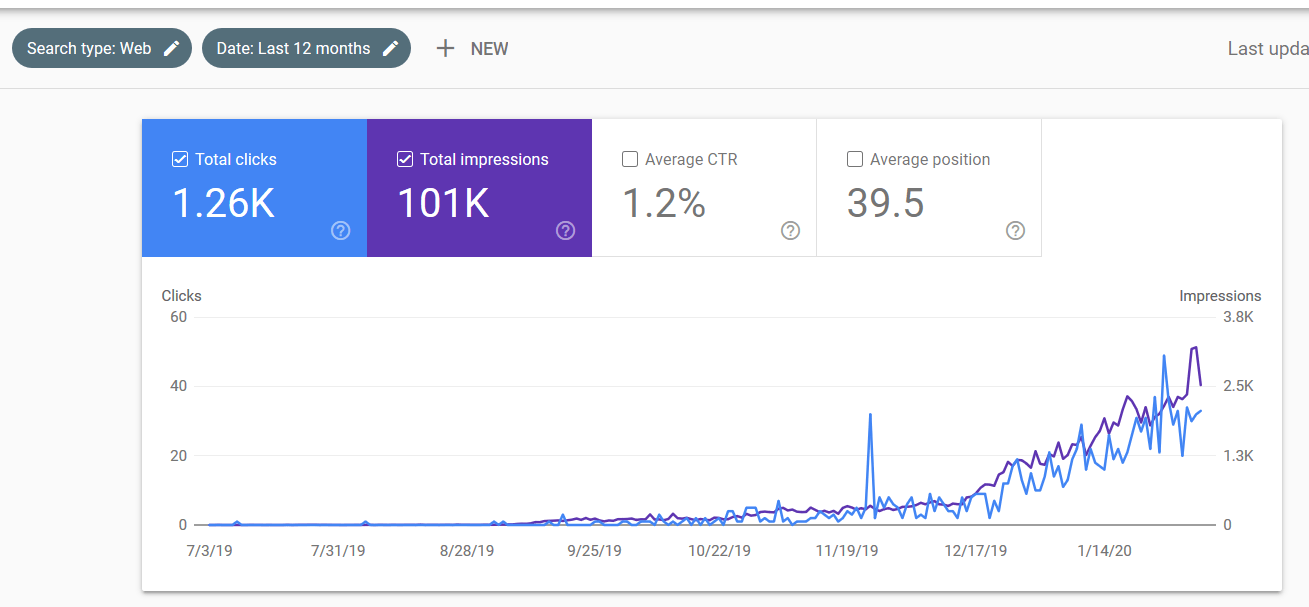
But traffic isn’t what makes you money blogging.
You also need affiliate links!
Add Affiliate Links
Affiliate marketing is basically how you make money blogging. So use your blog to promote affiliate products and/or services.
Whenever you create a new blog post, add your affiliate links naturally within the content.
You can even display ads of your affiliate programs on your blog to make money.
Whatever you do, make sure that your links are correct, or you won’t get affiliate commissions when visitors click through and buy products.
Once you’re done with this first phase, it’s time to move on to phase 2 – the Make Money Phase!
But before you proceed, here’s a word of caution…
If you haven’t crushed Phase 1, you aren’t ready for Phase 2. So make sure you’ve published enough SEO-optimized posts on your blog that you’re bringing in some serious traffic before you jump to the make money from your blog phase.
How much traffic is ‘serious’ traffic? You want to be averaging about 50 clicks per day. If you’re getting that kind of traffic through shotgun SEO, Phase 2 will really help you to increase your earnings!
SEO Phase 2 – How To Make Money Blogging
Phase 2 of make money blogging involves helping people actually find what they're looking for once they reach your blog.
This is also the phase where you start making more money. In fact, this is the level-up that a lot of inexperienced bloggers miss! And it can cost you thousands of dollars in potential sales.
How To Launch Phase 2 SEO To Make Money Blogging

So, how do you help people find what they’re looking for via your affiliate marketing blog? There are two ways:
- Through your internal linking structure
- Through the structure of your website in general
Basically, in this phase you’ll learn how successful bloggers use search engine optimization together with a logical site structure to help their audience find what they are looking for… even if those visitors are not 100% sure that they know what they need to solve their problem.
And once you learn how to help people find what they’re looking for, they’ll obviously come to you whenever they need help. This means more traffic and definitely more income for you.
Now, let’s take a detailed look at how to use these two ways to fulfill your goal of helping people out (along with earning money) with your content.
How To Lay Out Your Website Architecture Like I’m Doing With My Affiliate Site (And Generate A 7-Figure Income)
Here comes the secret weapon I promised you at the beginning….
This step by step process will help you go from small-time sales to BIG TIME MONEY… using the exact same methods that I'm using.
But before diving into the money-minting process, here’s a disclaimer…
This is not EASY!
This is not easy money. It takes hard work and planning to make money blogging… but it’s worth it because you’re doing what you love!
In case you’re looking for a video tutorial, here’s the exact SEO process for my affiliate marketing website that I taught my team of bloggers. Watch it till the end to learn how you can blow your traffic and sales numbers out of the water!
In this video, you’ll see the following critical steps on how to make money blogging. Many bloggers are following these steps and generating a steady income over time doing so.
Step 1: You Map Out The Categories, Sub Categories, And Long-tail Keywords
The first step is to figure out, from a user’s perspective, how to help your visitors find what they're looking for.
Every website has one or two main topics. Under those main topics, you’ve got a few subcategory ideas. And then under each subcategory, there are often 2-3 or even more specific keyword ideas, which are basically long-tail keywords.
The idea is to create an awesome post for each main topic, and then branch off of into sub-categories, and then off of those to create posts on specific long-tail keywords.
This is what is known as an SEO Silo!
Let’s consider an example to understand better…
Suppose you have a knife review site.
So what you do is you start with the KGR pack, and use all of these low competition long-tail keywords to create blog posts.
One such blog post might be something really specific, like ‘The best paring knife for peeling apples.’
You might have dozens of these types of posts underneath a larger sub-category post on ‘The 7 Best Paring Knives For Kitchen Use,’ etc.
Here’s the bottom line….
You let the customer’s need be your guide, and create your content with the end-user in mind. If your target audience needs a certain thing within your niche, you add it and make it a relevant part of your silo, in the most ideal spot to make it easy to find.
To get into the million-dollar-level of the business, you need to prioritize care, concern, and stewarding for your readers.
Step 2: Come Back And Fill In The Blanks To Flush Out Your Silo

After you’ve created 100 or so blog posts, you'll be ready to really start building out an SEO Silo. Some marketers call these ‘content clusters,’ but the idea is the same.
An SEO Silo is a website structure which divides the content into different categories and subcategories, and then sorts relevant, long-tail, specific posts underneath these overarching categories to create a sorting structure, or SEO Silo, that organizes all of the content, making it easier to be found and indexed by search engines, and more easily navigated by visitors.
So when you are building a silo, you want to link all of your content together strategically. If your users aren’t exactly sure what they’re looking for, you can help them by linking each post back up to its category, by having a list of categories at the top of your site page, by arranging content so as to make it intuitive and easy to find, etc.
You can actually help them find what they want through internal linking and your blogging site design.
We’ll discuss this more shortly.
For now, let’s go back to our knife review site example.
So our main topic is ‘knife review,’ and we can segment it into two categories: Kitchen and Outdoor.
Under the Outdoor category, we’re going down the road of camping, bush crafting, and hunting knives. We’re basically laying out our content ideas based on a logical idea of what visitors might be searching for.
Now under each of these sub-categories, you’ll have a couple of ideas. For instance, under Bushcrafting knives, you can talk about whittling knives and buttoning wood. Under camping knives, you can cover foldable knives or fixed blade knives. Similarly, under hunting, you can include knives for boning, for skinning, etc.
So this is basically how you arrange and plan out all of the different categories and posts that you’ll need to have. You can map it all out, and then start filling in the blanks when you get to phase 2.
If you have a very large divide in your website, like outdoor vs indoor and kitchen vs outdoor, sometimes it makes sense to take on one of these categories first, and go all the way through it… because you can really build it out and start getting traffic to that silo while you are building the others.
Before you proceed with this step, here’s a caveat…
Laying this out for planning can be a messy process. And, you may need to do it over and over again to really refine it and get it right.
Step 3: Linking Structure

Your linking structure is very important!
Why?
Because you want to make sure that if a user lands on one of your pages (let’s say skinning knives) while they’re actually looking for boning knives, you need to make sure that you’ve got a link in that post that will take them to your post on boning knives.
You also want the post to link back up to the higher level, so your user can actually work their way through the content. They must be able to find the exact thing that they want because that’s how you make money.
You see, the process involved in this step isn’t only prioritizing algorithms and keyword research. You also need to prioritize the humans who will land on your blog, and try to help them!
Always think about the user experience. It is paramount!
When I started out, I got 60+ posts on my blogging site. So now I’m looking to create natural pathways that will enable visitors to navigate my blog to get that exact item they want. Because when they find it, that’s when they buy. And that’s when I generate income.
Let’s dive deeper into this step by considering our knives example.
Suppose we’re talking about prep knives, all-around knives, cooking knives, etc. Now under cooking knives, we’d talk about steak knives and carving knives. Under all-around knives, we’ll include a Chef’s knife. And under prep knives, we could have knives for meat, fruits and veggies, and bread, including serrated knives. Fruit and veggie knives can be further broken down into a chef’s knife, Satoru knife, Nakiri knife, paring knife etc.
The idea here is to figure out, from a user’s perspective, who your audience is, what they need, and what they are looking for.
Then, you figure out how to build this into your content.
Wondering how to use this layout?
The blog post that you create on prep knives is going to cover meat knives, fruit and veggie knives, and bread knives. So you will also want to create individual posts for all of those types of knives, and link down to them from your prep-knives post.
This helps your visitors to find them easily, instead of needing to waste time cycling through your blog list.
Why do we link?

Because when Google crawls your site, those links are going to help it understand that this is a knife related site, and that it covers all of these different topics… because it can follow the links all throughout your content.
And this makes your site look valuable to Google, because it is providing such a wealth of focused information.
The bottom line is….
Make this mapping as clear as possible, and follow one logic chain all the way down to the bottom.
This means linking down from your homepage (something about best knives online), to the first subset (Seven best kitchen knives), all the way down to the separate blog posts on kitchen knives for fruits, veggies, meats, etc, and so on.
This way, each post is linking down through the content itself.
How Do You Help People Find The Content They Need?

One really interesting thing I've noticed about my affiliate site is that I get a lot of people landing on certain blog posts, then clicking back up to the main blog menu.
This tells me that people aren't finding what they're looking for in those blog posts, so they are trying to click to the best place to find it.
Awesome. One very crucial part of SEO Phase 2 is helping customers with this process.
What can you do to help them with this?
There are a couple of different ways to do this.
But one way is by putting helpful menu icons or topics along the top menu of your site.
You do, however, need to make sure that the menu items you choose are customer-focused.
In other words, you might be tempted to categorize the different knives listed on your site by brand. But this isn't really going to help someone who is looking for the best steak knife.
Instead, have a ‘Kitchen Knives' menu option along the top of your site. If they land on a blog post that doesn't quite give them what they need, they'll click up to your menu and start following that link trail.
This also helps them to understand what they are looking for if they weren't quite sure what they needed before. Maybe they know they need a salmon knife… but are not sure which knife is best for salmon!
You also place links within your content to help people navigate between different pages. The theory is that your page will include H2s based on different subsets you just mapped out. So in posts like the 10 best knives for cutting beef, you will have 10 different knives… with each major H2 linking to a more specific article that offers 10 different options for that specific type of knife, etc.
Don’t Forget… As Affiliate Marketers, Our Job Is To Help People Find What They Are Looking For

You can see this in action on my site. You’ll see there are eight icons (Email Marketing, Facebook Advertising, Mindset, Sales Funnel, Search Engine Marketing, Social Media Marketing, Online Business, and Daily Emails). Those are my main categories of content.
So if someone lands on my website who is specifically interested in sales funnels, they know where to click.
I’m not making it difficult for them to find what they are looking for. I'm trying to make it super easy.
Affiliate Market Case Study Update: Month Number 8
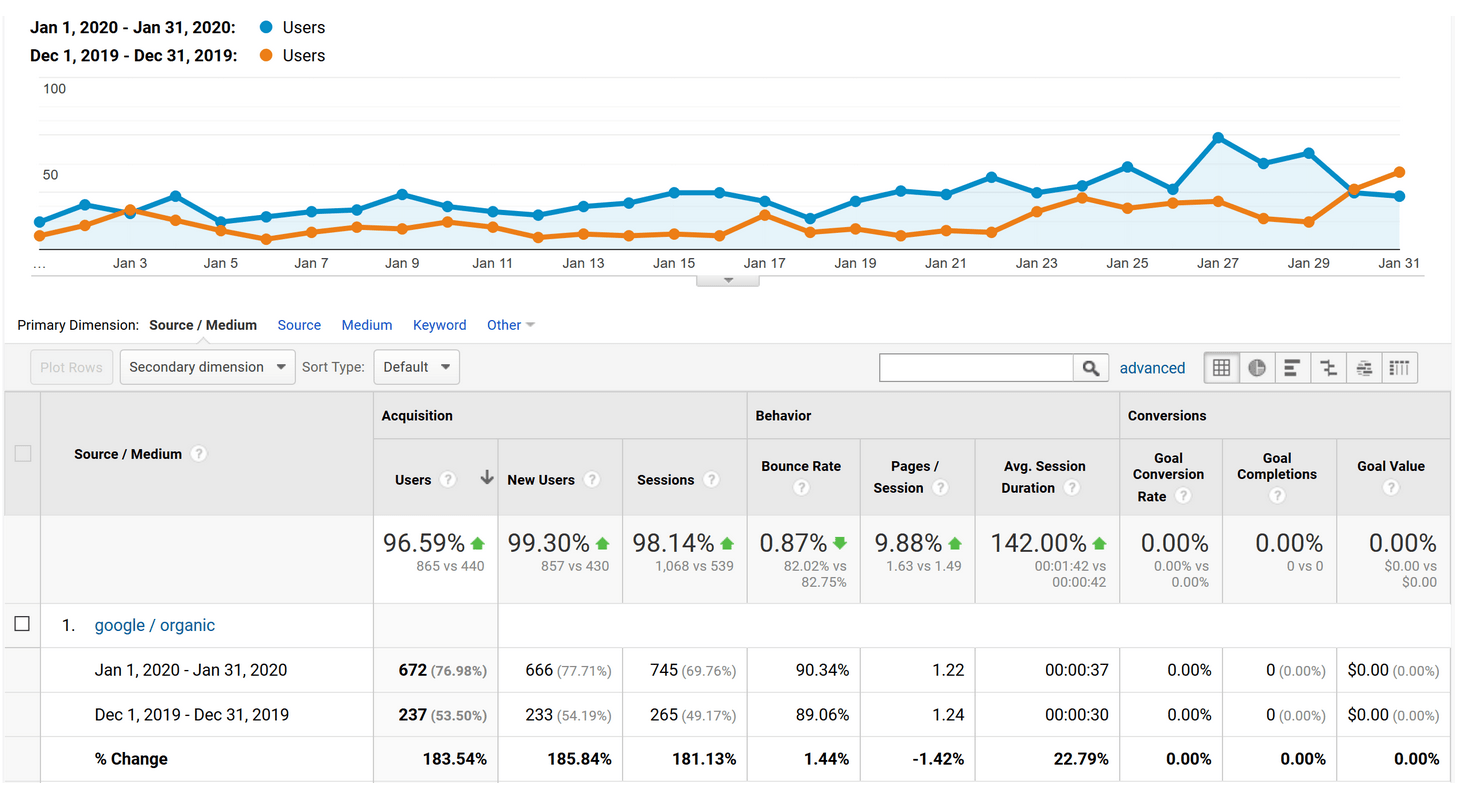
As you know, this is month number 8 of my affiliate market case study.
This was my hypothesis: My team and I can build an affiliate marketing website from zero to $3,000 a month revenue in one year.
Here are the important stats to note from Month 8!
How Much Did The Site Earn?
This month, the site actually earned over $80! That is a HUGE increase above and beyond what it earned last month! Check out these figures for Canada and US sales…
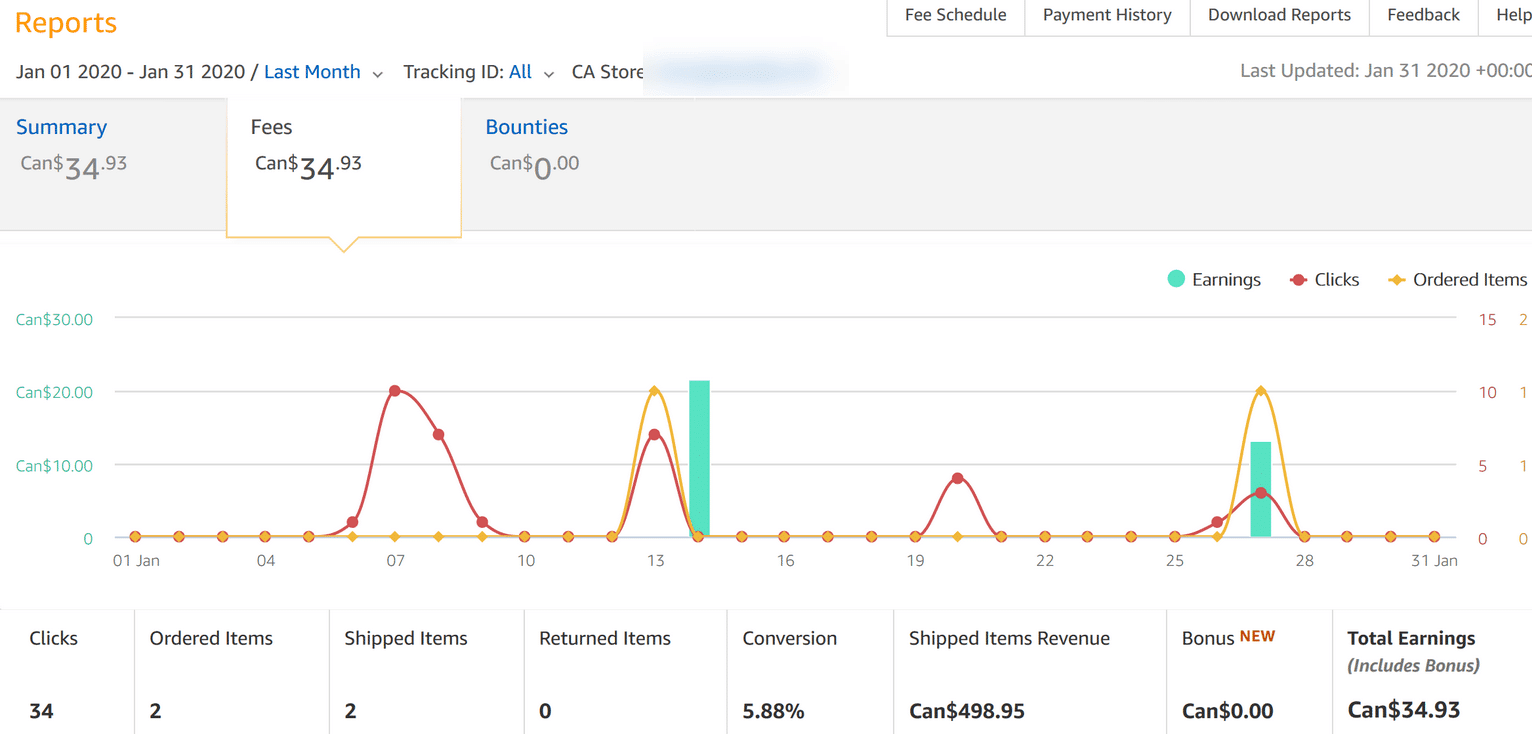
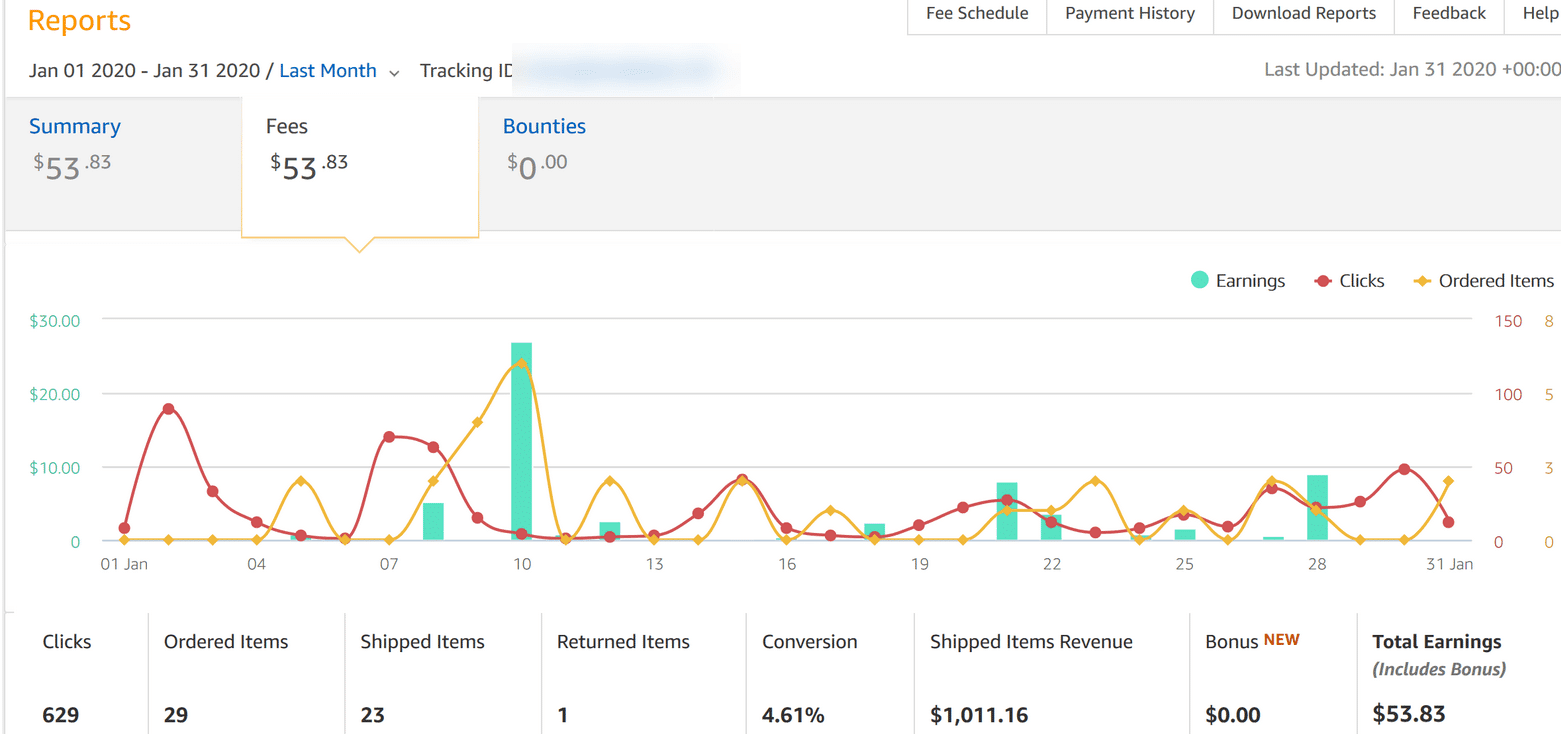
This just goes to show the power of compounding in affiliate marketing. Last month, the site did about $5 in sales. And this month, as you can see, the increase was massive!
Now, you won’t be able to expect massive increases all the time… but a 20, 40, or even 60 percent increase in traffic month to month, in the beginning, does mean that you are looking at healthy signs of a healthy blog that is probably going to do very well!
How Much Was Spent?
Here is how much was spent on the site during the month of January…
- Editing: $862
- 15 Articles: $1,293.12
- Writer job posting: $140
- Management: $750
Total invested in the last 30 days, $3,045.12
Total invested in the 8-month life of the website so far, $26,189.
Of course, this might look like a lot of money to someone who is just getting started. But keep in mind that I am doing all of this with a completely hands-off approach! All of this is being done by a team that I’ve assembled for the task.
If you were to want to duplicate these results, you could easily do it yourself by working a few hours every day to set up your site, write your own posts, do your own keyword research, etc.
You can absolutely turn those dollars into manpower hours, and go to town on it without spending much at all!
Conclusion
As you can see, building a high-performing blog that earns money takes time and effort. But hopefully, this ‘start a blog how to' has helped you to see that it is possible to start making money sooner than you thought with your blog.
There are numerous income streams and ways to make money blogging. Of course, you can sell digital products, you can sell physical products through affiliate marketing… and/or, you can start making money every month, per month, asking each visitor for their email address and using email marketing to market your products to them on the back end.
And these are just a few of the different income streams you can make use of through blogging!
And this is why I’ve said time and time again, it’s really a race to hundreds upon hundreds of posts when it comes to blogging… and hopefully, this ‘starting a blog how to' has given you the tools you need to get started, and go from beginner to phase 2 of the process.
Ultimately. to create a really successful blog, you’re going to have to write content for years on end. It’s going to take hundreds of posts!
But when your website becomes a helpful resource that allows people to quickly find what they’re looking for… well, that is when bloggers will really start to make money blogging!
Once you do start making income, you can outsource content creation to external bloggers or hire in-house bloggers… whatever you like, or whatever suits your needs.

